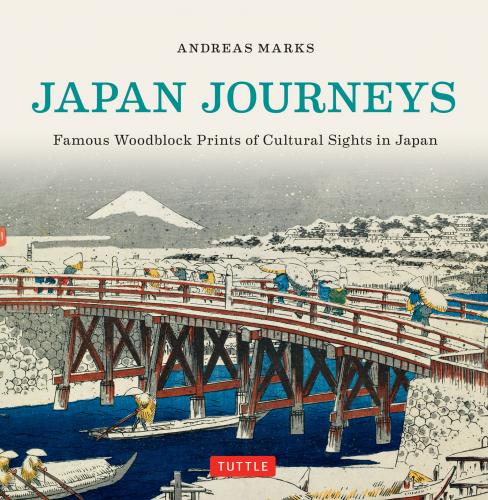Japan Journeys. Andreas Marks
on>
1859, Utagawa Sadahide, Cool Evening at Shijogawara during the Gion Festival in the Imperial Capital.
1858, Utagawa Hiroshige, The Sea off Satta in Suruga Province (detail), from the series Thirty-six Views of Mount Fuji.
1820s, Shotei Hokuju, True Depiction of the Monkey Bridge in Kai Province.
Japan Journeys
FAMOUS WOODBLOCK PRINTS
OF CULTURAL SIGHTS IN JAPAN
ANDREAS MARKS
TUTTLE Publishing
Tokyo | Rutland, Vermont | Singapore
Ca. 1765–1770, Suzuki Harunobu, Woman and Child Catching Fireflies.
Contents
A Paradise for Travelers
CHAPTER 1
Sights of Tokyo
Nihonbashi
Asakusa
The Sumida River and Ryogoku
Tokyo Imperial Palace
The Floating World
Edo-era Dining
The Ginza
Tokyo Station
Shops and Trades
Ochanomizu and the Kanda River
Temples and Shrines
Tokyo Festivals
Railways
CHAPTER 2
Sights around Tokyo
Yokohama
Kamakura
Nikko
Hakone
Mount Fuji
CHAPTER 3
Sights of Kyoto
Old Kyoto
Traditional Pastimes
The Gion District
The Heian Shrine
Kiyomizu Temple
Kinkakuji Temple
Arashiyama
CHAPTER 4
Sights of Japan
Nara
Osaka
Castle
Itsukushima
The Wedded Rocks of Futami
Other Scenic Highlights
Picture Credits
Full Versions of Cropped Images
1851, Utagawa Hiroshige, Lake in the Mountains of Hakone from the series Thirty-six Views of Mount Fuji.
The procession of a feudal lord crosses Yahagi Bridge towards Okazaki, whose castle, birthplace of the founder of the Tokugawa shogunate Tokugawa Ieyasu, is in the background. Ca. 1832–1833, Utagawa Hiroshige, Okazaki: Yahagi Bridge (detail), from the series The fifty-three Stations along the Tokaido.
A Paradise for Travelers
In nineteenth-century Japan, after centuries of civil war and restrictions on individual mobility, travel became a popular leisure activity, thanks in part to the development of a network of well-built and fairly safe roads. Instead of a rough ordeal into the unknown, traveling was expected to be pleasurable and to provide opportunities to experience culinary and cultural specialties, local color, and other entertainments. This new interest in travel and enjoyment of local culture is reflected vividly in the woodblock prints of the period. Prints featuring the natural beauty and architectural riches of various regions of Japan started to gain widespread popularity by the 1830s, giving birth to a new category of print that served as an affordable memento for travelers. Thus historic views of Japan’s favorite sights have been preserved over the generations, offering a fascinating perspective on familiar cultural icons for tourists both domestic and foreign today.
TRAVEL AND PRINTS
The origin of the travel boom in Japan is found in the pilgrimages to sacred sites that became widespread among all classes during the nineteenth century. Accurate statistics of domestic tourism at this time do not exist, but it is estimated, for example, that as many as five million people participated in the 1830–1831 mass pilgrimage to Ise when the total population of Japan is believed to have been 32 million. To facilitate the growing number of travelers, lodging and dining opportunities, as well as other services, were established, especially along the main arterial roads like the Tokaido highway that connected Edo (today’s Tokyo) with Kyoto. This interest in travel and depictions thereof was further bolstered among the masses by travel stories like the bestselling serial novel by Jippensha Ikku (1766–1831), Strolling Along the Tokaido, also known as Shank’s Mare in English.
The customer seated on the left, playing the popular parlor game ken with a woman, is believed to be Hiroshige himself. Ca. 1838–40, Utagawa Hiroshige, Musashiya Restaurant in Ushijima from the series Collection of Famous Restaurants in Edo.
By shogunal decree, with very few exceptions, Japan had limited contact with foreign countries until the 1850s, when the American navy forced Japan to open its doors to the West. This opening was swiftly followed by an unparalleled modernization and Westernization in the late nineteenth and early twentieth centuries. The development of railways facilitated rapid urbanization and along with that came a shift away from traditional lifestyles.
In the twenty-first century, when social networking has created a demand for a constant photographic recording of one’s life, the urge for documentation is especially apparent in the behavior of tourists, where excessive photographing and digital sharing seems to have largely replaced the once obligatory postcard writing. An obsession with capturing scenes visually has always been noticeable in Japan: in the late twentieth century, the camera-wielding Japanese tourist was a common stereotype worldwide. This interest in documenting travel is not new, and is one of the reasons why thousands of different views of Japan’s scenery were offered as commercially produced woodblock prints in the eighteenth and nineteenth centuries. Such prints were attractive not just as a memory of a past trip but also as a visualization of a desired future journey. Today they allow us a glimpse of life at that time and provide also an image of the scenery then, although we should keep in mind that views of remote locations weren’t necessarily accurate representations but rather idealized interpretations by artists who usually
